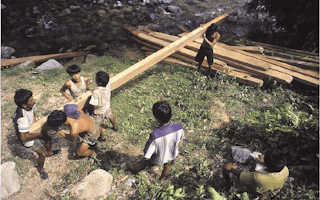The current finger pointing and combative rhetoric by all parties involved in the recent haze outbreak is not the path to constructive long lasting solution.
To continue reading, subscribe to Eco‑Business.
There's something for everyone. We offer a range of subscription plans.
- Access our stories and receive our Insights Weekly newsletter with the free EB Member plan.
- Unlock unlimited access to our content and archive with EB Circle.
- Publish your content with EB Premium.
We must build deep, open, honest and transparent collaborations for the next decade and beyond, and use this ‘Haze 9/11’ event that will never be forgotten. I call it that because of the severity of this problem - the worst on record - and because it is man-made. We need to use this as the motivation to find ‘long lasting political will’ in companies, communities and government to finally solve this persistent and recurring problem.
Carbon Conservation has been working on avoided deforestation, stopping the haze and helping industry towards a more sustainable business model for seven years in Indonesia.
The sad fact is that behind the two super powers America and China, Indonesia is the third biggest emitter of greenhouse gases simply because of this forest clearing and burning.
So how do we solve this?
I believe that this is a man-made problem and thus is absolutely solvable. I do not buy into the argument by naysayers who say fires will always burn and I believe that where there is a will there is a way.
But to find the right solutions we need to be open-minded and collaborative with all stakeholders. We all just need to stay calm and carry on.
We need to look at and evaluate all possible options - both ‘carrots and sticks’.
Some form of carrots include payments to the people on the ground to value and protect the peatlands and forests. We can explore innovative ideas like incentivizing forest stewardship and fire avoidance by rewarding those communities for the years where there are reduced or no hotspots, and reduced or no haze.
This then could possibly be even parlayed into a regional carbon market hub in Singapore where companies buy carbon credits to offset their footprint by buying ‘anti-haze’ community carbon credits.
We have a pilot project in Riau that would protect deep peat forest and could avoid the fires in the critical Kampar Peninsula peat dome area on the Sumatra island where the haze is originating from. But we were unable to raise finance in 2009 to 2010. Now with other industry partners, I hope to relaunch this effort and possibly build a bigger regional area of protection.
A Singapore-based regional carbon market for such credits is viable. China’s Shenzhen, for example, just launched a regional Chinese domestic carbon market this week. In 2009, the United States (under the Waxman Markey Bill) came within inches of a market policy that would have included forest carbon within its trading boundaries. Unfortunately, despite President Obama’s support, both Democrat and Republican Senators failed to support the Bill seeing it as a threat to fossil fuel industries and America’s economic competitiveness.
Ironically and interestingly, the voluntary market report which was released just two days ago by the Washington DC-based thinktank ‘Ecosystem Marketplace’ showed that voluntary markets are healthier than compliance markets with average 2012 prices of US$5.90 per tonne down only a fraction from USD $6.20 in 2011 and traded volumes were actually up about 4 per cent to 101 million tonnes.
Solutions could also involve the labeling of all products carrying inputs from the burning areas and also identification of owners of the offending concessions known to contribute to the haze.
This could then help with tighter and more accountable concession fire management and supply chain transparency and management so as to allow consumers to discern and decide where to spend their dollars.
The solutions might also involve encouraging the Indonesian Government to consider domestic ‘sticks’ or enforcement of ‘zero burn’ laws which Indonesia has but doesn’t widely enforce. Or perhaps just allowing the ability for Singapore to mobilize water bombing efforts in circumstances of such serious haze. At what point can a country defend its sovereign right to clean air for its kids?
But first, there needs to first be building of relationships based on trust and transparency, where we come together to find mutually agreeable solutions. Unless we see the common win-wins of all our children enjoying fresh air and economic development then our efforts will be doomed to failure. And indeed, the rift of ‘us vs them’ will grow ever deeper when we should all be prospering together.
The best example of global solutions was said to be the Montreal Protocol, an international treaty designed to protect the ozone layer, owing to its widespread adoption, collaboration and successful outcomes.
“
Some form of carrots include payments to the people on the ground to value and protect the peatlands and forests. We can explore innovative ideas like incentivizing forest stewardship and fire avoidance by rewarding those communities for the years where there are reduced or no hotspots, and reduced or no haze.
A trust-building bilateral example is where Australia will send firefighters to California to help fight their bush fires in the Australian winter. Unfortunately, the most notable and relevant example of a challenged international collaboration is the Kyoto Protocol and the United Nation’s climate change process owing to very divided interests and a misalignment of goals and desired outcomes. We cannot let this happen here, it must be win-win and not a binary win-lose outcome or else nothing will be achieved.
But there is a silver lining in this Haze 9-11. Seven years ago, when grisly images of burnt orangutans and devastated forest areas first moved my team and I to raise finance for forest carbon and motivated Carbon Conservation’s first forest projects in Indonesia, what we lacked was the momentum, awareness and sustained interest of society. We asked: ‘How could we rally the importance of this issue?’
Now, environmentalists have the momentum, the attention and support of society and so we must operate in pragmatic, realistic, achievable and transparent rational steps.
The simple fact is that we operate in a capitalist world with multiple sovereign governments representing different voter bases but we all must recognise that we are bound by some common questions: What wealth is worth having?
What is the value of economic development or wealth if children across Southeast Asia develop massive systemic respiratory problems? How do we put a value on clean air and on the protection of standing forest when it is twenty times cheaper to burn to clear land? And at what point do we truly fight for what’s right?
Sometimes it takes a crisis to solve a crisis and I think with Haze 9-11 that time has finally arrived.
Dorjee Sun, Director of Carbon Conservation and Carbon Agro has received the African Rainforest Conservation Earth Day Species Award as well as been named one of TIME Magazines Heroes of the Environment











